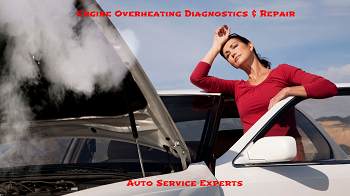Thermostat Replacement and Repair
Auto Service Experts San Antonio Auto Repair Shop
Replacing a thermostat is a comparably minor and inexpensive repair but an extremely important one. A bad thermostat can quickly lead to major cooling system problems and engine damage due to overheating. Auto Service Experts full-service auto repair shop employs ASE Master Technicians and certified mechanics who specialize in complete cooling system repair, maintenance, and diagnostics. Our garage is equipped with state of the art automotive equipment, tools, and computer diagnostic software to get your vehicle back on the road as soon as possible.

Engine Overheating Diagnostics FREE With Repairs.
The thermostat operates using thermal resistors which open and close regulating the flow of coolant through the engine and radiator. It remains closed until the engine reaches optimum operating temperature, then it opens to allow coolant to flow through the system and prevent overheating. Optimum engine operating temperature is the temperature range which is ideal for peak engine performance and maximum efficiency, 195-220 degrees Fahrenheit for most vehicles.
Signs You May Need to Have Your Car’s Thermostat Replaced
-You see the temperature gauge reach the red zone when the engine has not been running for a long time. This is typically the first warning sign of engine overheating and should be checked out immediately. When this occurs, pull over, turn off the engine, and wait for the engine to cool completely before attempting to drive. Remember, you don’t have to drive for long before overheating causes permanent engine damage, so in some cases, it is better to have the vehicle towed to an auto repair shop near you for diagnostics. Thermostat replacements cost thousands less than engine replacements or rebuilds.
-The temperature gauge fluctuates between abnormally high & low temperatures. Even if the gauge doesn’t remain in the red for long, dramatic temperature changes alert you to problems with the thermostat and cooling system which will cause engine damage if not repaired in a timely manner.
-You see coolant dripping from the thermostat, signs of coolant seeping out onto the housing or around the mounting surface, or evidence of coolant on the ground beneath the vehicle.
-Your car heater is not working. Your heater relies on hot coolant flowing through the heater core, where it warms the air flowing through the vents into the cabin. A bad thermostat may get stuck open, not allowing the engine to warm up enough to sufficiently heat the coolant. If it is stuck closed, coolant is not allowed to flow through the heater core to warm the air. For this reason, it is important to have your heater and other auto HVAC components inspected and repaired at the first sign of a problem, even if the weather is nice enough to go without your AC or heater.
Common Thermostat Problems
Stuck Thermostat
A failed thermostat gets stuck in either the open or closed position. Either way, it causes serious engine problems and prevents the heater from operating properly. If stuck open, coolant constantly flows and causes the engine to “run cold” (never reaching optimum temperature). This leads to performance issues, decreased fuel efficiency and increased emissions due to “gas dumping”. It also causes more wear and tear on engine components over time, but is not nearly as damaging as running hot.
When the thermostat is stuck in the closed position, coolant circulation is restricted. Coolant is blocked from the radiator and the engine quickly overheats. Driving under this condition can destroy your engine in a matter of minutes. Thermostat replacements are minor and inexpensive compared to an engine overhaul, so this is a repair you never want to put off.
Thermostat Leak
The thermostat is contained in a plastic housing which can become brittle and crack over time, allowing coolant to leak out. Coolant may also seep out through improperly sealed gaskets around the mounting surface. Gasket seals can fail over time as they become hard, cracked, or corroded. In new thermostats, leaks are often due to improper installation. Sealant may have been improperly applied, the wrong sealant used, or there may have been dirt or contamination on the gaskets or mounting surface which prevented them from sealing completely.
Corroded, Rusted, or Clogged Thermostat
Deposits, contaminants, and sludge can build up on internal components and prevent them from operating as designed. The most common cause of a clogged thermostat is the failure to keep up with necessary maintenance including cooling system flushes or coolant changes. Using the wrong type of coolant for your vehicle or mixing different types can also cause clogs. A broken pressure cap can increase the rate of oxidation by allowing air bubbles into the system.
